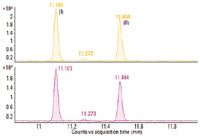Method for the Determination of Chemical Contaminants in Marine Shellfish
Chemical contaminants that are released into the marine environment may be ingested (absorbed) by fish and shellfish and thus become introduced into the human food chain.
INTRODUCTION
Chemical contaminants that are released into the marine environment may be ingested (absorbed) by fish and shellfish and thus become introduced into the human food chain. Lipophillic chemicals such as OCPs and PCBs can bioaccumulate in the fatty tissues of marine fish and shellfish. The longer an organism is exposed to a contaminated environment, the higher the likely levels of contaminants
The Clean Seas Environmental Monitoring Program (CSEMP) is an initiative designed to monitor the levels of chemical contamination in the United Kingdom's coastal and estuarine areas. The major drivers for this program are:
- To meet the mandatory monitoring requirements under Oslo and Paris Convention (OSPAR) Joint Assessment and Monitoring Program (JAMP)
- To comply with EC Directives.
Agilent Technologies has partnered with a leading European Analytical Laboratory to develop a sample preparation method based on a modified QuEChERS extraction along with a GC/MS/MS method for the determination of selected OCPs, PAHs, and PCBs in marine shellfish (Mussel) tissue. The GC/MS/MS method provides reproducible and sensitive determination of OCPs, PCBs, and PAHs that employs large-volume (solvent vent) injection using a Multimode inlet (MMI) and post-column, post-run backflush in order to remove high-boiling matrix components that would otherwise remain in the column between analyses and subsequently cause degradation of chromatographic performance and contamination of the mass spectrometer ion source.

Figure 1. TIC MRM chromatogram of a calibration standard mixture of OCPs, PAHs and PCBs*
The analytical method meets the detection limit requirements of 0.1 µg/Kg for OCPs and PCBs, and 0.5–1.0 µg/Kg for PAHs.

Figure 2. MRM chromatograms for (I) incurred a-HCH and (II) incurred g-HCH in mussel sample, concentrations 0.06 and 0.30 µg/Kg, respectively. Peaks (III) and (IV) are traces of incurred b-HCH and d-HCH, respectively
COMPOUNDS
- 16 OCPs
- 19 PAHs
- 7 PCBs
KEY BENEFITS
- Sample extraction based on a modified QuEChERS method
- Recoveries for all analytes in the range of 85.4% to 123.9%
- Large-volume (solvent vent mode) injection using a multimode inlet ensuring required detection limits are met
- Retention time locked chromatographic method for ease of set-up and on-going maintenance
- Capillary flow technology for post-column, post-run backflush to ensure chromatographic method robustness and prevent contamination of the MS ion source with high-boiling matrix
- Mass Hunter software that is very powerful yet easy to master, providing excellent data review capabilities and easy, flexible reporting.

Figure 3. MRM chromatograms for (I) incurred fluoranthene and (II) incurred pyrene in mussel sample, Concentrations 8.64 and 5.83 µg/Kg, respectively
* Full analytical details are available in Agilent Technologies publication 5990-7714EN.
Agilent shall not be liable for errors contained herein or for incidental or consequential damages in connection with the furnishing, performance, or use of this material. Information, descriptions, and specifications in this publication are subject to change without notice.
Separation of Ultra-Short and Long Chain PFAS Compounds Using a Positive Charge Surface Column
December 11th 2024A separation of ultra-short and long chain PFAS (C1-C18) is performed on a HALO®PCS Phenyl-Hexyl column along with a HALO®PFAS Delay column which demonstrates excellent retention for both hydrophilic and hydrophobic analytes.
